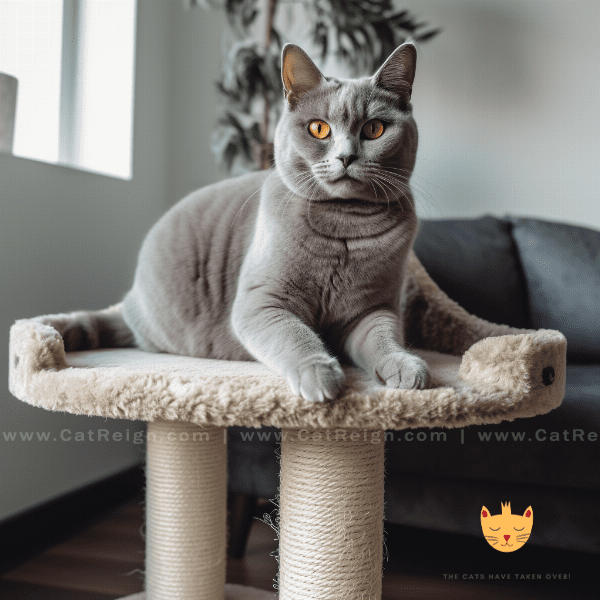Table of Contents
- Understanding Why Cats Scratch
- Providing Suitable Scratching Alternatives
- Using Deterrents to Protect Furniture
- Trimming Your Cat’s Nails Regularly
- Creating a Positive Reinforcement Environment
- Covering Furniture with Scratch-Resistant Materials
- Consistency and Persistence in Training
- Seeking Professional Help if Needed
- Managing Stress and Anxiety in Cats
- Conclusion: Keeping Your Furniture Scratch-Free
Understanding Why Cats Scratch
Cats are known for their scratching behavior, but have you ever wondered why they do it? Understanding the reasons behind this natural feline behavior is the first step in preventing them from scratching your furniture.
It’s a Natural Instinct
Scratching is an instinctual behavior for cats. In the wild, cats use their claws to hunt, climb trees, and defend themselves against predators. Domestic cats may not need to do these things, but their instinct to scratch remains strong. Scratching also helps cats to stretch their muscles and maintain healthy claws.
Marking Territory
Cats also scratch as a way to mark their territory. When a cat scratches an object, it leaves behind visual marks and scents from the sweat glands in their paws. This signals to other cats that the area is claimed and warns them to stay away.
Communication
Cats also use scratching as a form of communication. When cats scratch, they leave behind visible marks and scents from their paws, which other cats can interpret as a message. Scratching can communicate a variety of things, such as a warning to stay away, a message of affection, or an invitation to play.
Emotion Regulation
Finally, cats may also scratch as a way to regulate their emotions. When a cat is feeling stressed or anxious, scratching can help them to release pent-up energy and reduce tension.
Understanding the reasons behind your cat’s scratching behavior is essential in preventing them from damaging your furniture. By providing suitable alternatives and addressing any underlying emotional or behavioral issues, you can help your cat to satisfy their natural instincts without sacrificing your favorite couch.
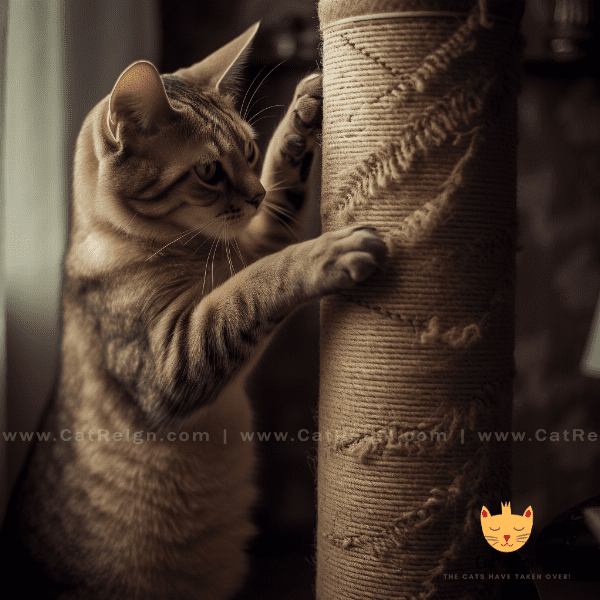
Providing Suitable Scratching Alternatives
Cats need to scratch, but that doesn’t mean they have to scratch your furniture. Providing suitable scratching alternatives can redirect their behavior and save your couch. Here are some alternatives you can offer your feline friend:
Scratching Posts
Scratching posts are one of the most popular alternatives for cats. They come in various sizes, shapes, and materials, such as carpet, sisal, or wood. Place the scratching post in an accessible and visible location, and encourage your cat to use it by rubbing some catnip on it.
Scratching Pads
Scratching pads are another option for cats. They are typically made of cardboard and can be placed on the floor or mounted on a wall. Scratching pads are cheap and disposable, so they’re an excellent choice if your cat is a heavy scratcher.
Cat Trees
Cat trees are not only great for scratching, but they also provide a place for your cat to climb, play, and rest. They come in various heights and designs, and some even have built-in toys and hiding spots. Cat trees are especially useful for indoor cats who need more exercise and stimulation.
Horizontal Surfaces
Not all cats prefer vertical scratching surfaces. Some cats prefer to scratch on horizontal surfaces, such as rugs or mats. If your cat is one of them, provide them with a suitable scratching mat or rug to satisfy their needs.
Providing suitable scratching alternatives is crucial in preventing cats from scratching your furniture. Experiment with different types of scratching surfaces to find out what your cat prefers, and make sure to offer multiple options in different locations. Remember, the key is to redirect their behavior, not to punish them for their natural instincts.

Using Deterrents to Protect Furniture
Providing suitable scratching alternatives is an excellent way to prevent cats from damaging your furniture. However, sometimes it may not be enough. In such cases, using deterrents can be an effective way to protect your furniture from scratches. Here are some deterrents you can try:
Double-Sided Tape
Cats dislike the sticky feeling of double-sided tape on their paws, so placing it on furniture can deter them from scratching. You can also use aluminum foil or sandpaper in the same way.
Citrus or Menthol Scents
Cats dislike strong smells like citrus or menthol. You can use citrus-scented cleaners or essential oils to spray on your furniture or use air fresheners with menthol scent to keep your cat away from your furniture.
Sticky Pads
Sticky pads are an excellent way to protect furniture from scratches. They have a sticky surface that can keep your cat from scratching your furniture. They’re easy to apply and remove and are not harmful to your cat.
Motion-Activated Deterrents
Motion-activated deterrents are another effective way to prevent cats from scratching furniture. These devices emit a loud noise or a burst of air when they detect motion, scaring the cat away from the furniture.
Using deterrents to protect your furniture from scratches can be a useful tool. However, keep in mind that they should be used in conjunction with providing suitable scratching alternatives, not as a replacement. Deterrents should be used to train your cat to scratch where it’s appropriate, not to punish them for their natural behavior.
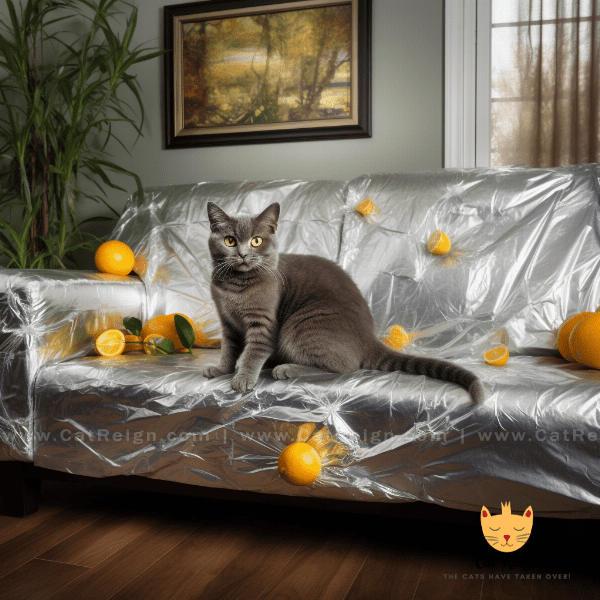
Trimming Your Cat’s Nails Regularly
Regular nail trimming is essential for maintaining your cat’s overall health and well-being. It also helps to prevent them from scratching your furniture. Here are some tips for trimming your cat’s nails:
Start Early
Start trimming your cat’s nails when they are still a kitten. This helps them get used to the process and makes it easier as they grow older. If your cat is already an adult, don’t worry. You can still train them to accept nail trimming with patience and positive reinforcement.
Get the Right Tools
Invest in a good quality pair of nail clippers designed for cats. Avoid using human nail clippers, as they can crush the cat’s nails and cause pain. You may also want to have some styptic powder on hand in case you accidentally cut the quick, which can cause bleeding.
Find a Comfortable Position
Choose a comfortable and secure place to trim your cat’s nails. You may want to place a towel or blanket on your lap or a stable surface to prevent your cat from slipping or running away.
Trim the Nails
Gently hold your cat’s paw and press on the pad to extend the nail. Use the nail clipper to trim the tip of the nail, being careful not to cut the quick, which is the pink part of the nail that contains blood vessels and nerves. If you’re unsure where the quick is, you can shine a light behind the nail to see it more clearly.
Reward Your Cat
Reward your cat with praise and treats after trimming their nails. This helps to create a positive association with nail trimming and encourages them to cooperate in the future.
Trimming your cat’s nails regularly can help to prevent them from scratching your furniture. It’s important to start early, use the right tools, find a comfortable position, trim the nails carefully, and reward your cat for their cooperation. If you’re not comfortable trimming your cat’s nails yourself, you can always ask a professional groomer or veterinarian for help.
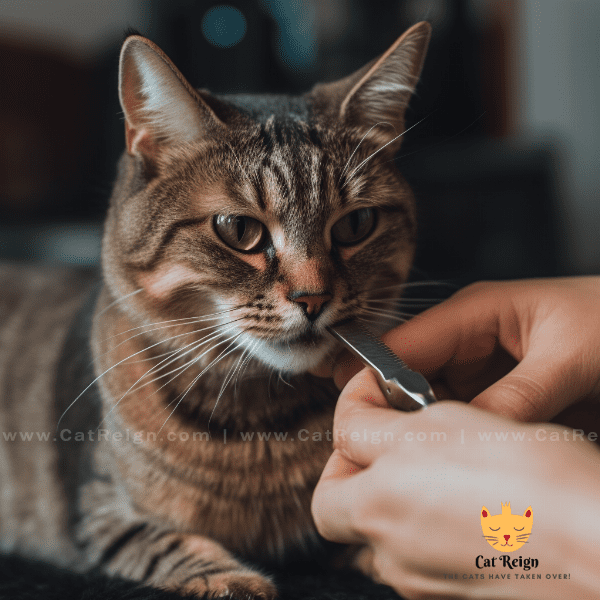
Creating a Positive Reinforcement Environment
Creating a positive reinforcement environment is crucial in preventing cats from scratching your furniture. By using positive reinforcement techniques, you can teach your cat to scratch in appropriate areas and deter them from scratching in inappropriate ones. Here’s how to create a positive reinforcement environment:
Reward Good Behavior
When your cat scratches in an appropriate area, reward them with treats, toys, or praise. This helps to reinforce the behavior and encourages them to continue scratching in that area. It’s important to reward them immediately after they scratch, so they associate the behavior with the reward.
Provide a Variety of Scratching Surfaces
Cats have individual preferences when it comes to scratching surfaces. Provide a variety of scratching surfaces, such as scratching posts, mats, and cardboard scratchers, to find out what your cat likes best. Place them in prominent areas around your house, such as near windows and furniture, to encourage your cat to use them.
Redirect Inappropriate Scratching
When you catch your Cat scratching in an inappropriate area, gently redirect them to an appropriate scratching surface. You can do this by using toys, treats, or a spray bottle filled with water. Avoid punishing your cat, as it can create fear and anxiety, and make the problem worse.
Use Pheromone Sprays
Pheromone sprays mimic the scent of a cat’s natural pheromones, which can have a calming effect and reduce anxiety. You can spray them on your cat’s scratching surfaces to encourage them to use them and on furniture to deter them from scratching.
Creating a positive reinforcement environment can take time and patience, but it’s worth it in the long run. By rewarding good behavior, providing a variety of scratching surfaces, redirecting inappropriate scratching, and using pheromone sprays, you can teach your cat to scratch in appropriate areas and keep your furniture scratch-free.
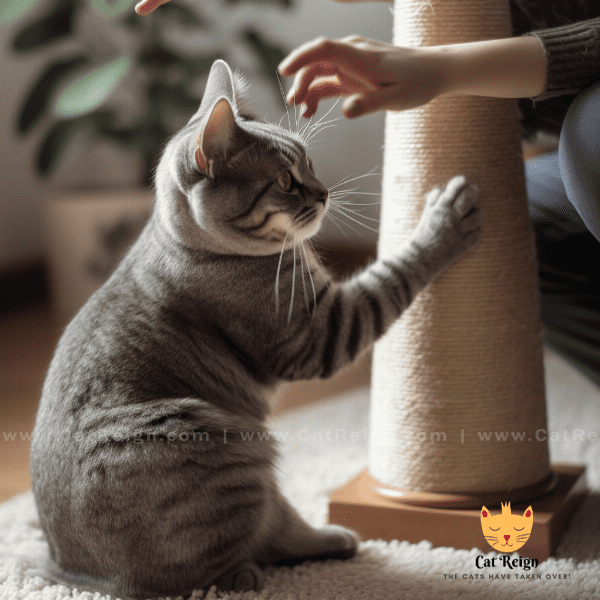
Covering Furniture with Scratch-Resistant Materials
If you’ve tried all the previous solutions and your cat is still scratching your furniture, covering it with scratch-resistant materials can be a good option. Here are some scratch-resistant materials you can use:
Microfiber or Leather Furniture
Microfiber and leather are two materials that are less likely to be scratched by cats. They’re also easy to clean and maintain, making them a practical choice for pet owners.
Slipcovers
Slipcovers are another option for protecting your furniture from scratches. They’re available in a range of materials and can be easily removed and washed. Slipcovers are also an excellent way to update the look of your furniture without having to buy new pieces.
Vinyl or Plastic Covers
Vinyl or plastic covers can also be used to protect your furniture from scratches. These covers are usually waterproof and easy to clean. However, they’re not the most comfortable option, so your cat may not enjoy sitting on them.
Anti-Scratch Sprays
Anti-scratch sprays are specially designed to deter cats from scratching furniture. They contain bitter-tasting substances that make the furniture unappealing to cats. These sprays are safe for cats and can be applied to a range of materials.
Covering your furniture with scratch-resistant materials can be an effective way to protect it from scratches. However, keep in mind that this solution is only a temporary fix. It’s important to provide your cat with suitable scratching alternatives and address any underlying behavioral issues to prevent them from scratching your furniture in the long term.

Consistency and Persistence in Training
Training your Cat to stop scratching furniture requires consistency and persistence. It’s essential to establish a routine and stick to it to achieve long-term success. Here are some tips for consistency and persistence in training:
Set Realistic Expectations
It’s important to set realistic expectations for your cat’s behavior. Cats are individuals with their own preferences and personalities, and it may take some time to find the right solutions that work for your cat.
Develop a Training Plan
Develop a training plan that includes suitable scratching alternatives, deterrents, and positive reinforcement techniques. Make a schedule and stick to it to establish consistency and routine.
Be Patient
Training a cat to stop scratching furniture can take time and patience. Don’t expect immediate results, and don’t get frustrated if your cat doesn’t respond right away. Keep trying and be persistent, and your efforts will pay off in the long run.
Use Positive Reinforcement
Positive reinforcement is a powerful tool in training your cat. Reward good behavior with treats, toys, or praise, and redirect inappropriate behavior with gentle guidance. Avoid punishing your cat, as it can create fear and anxiety, and make the problem worse.
.
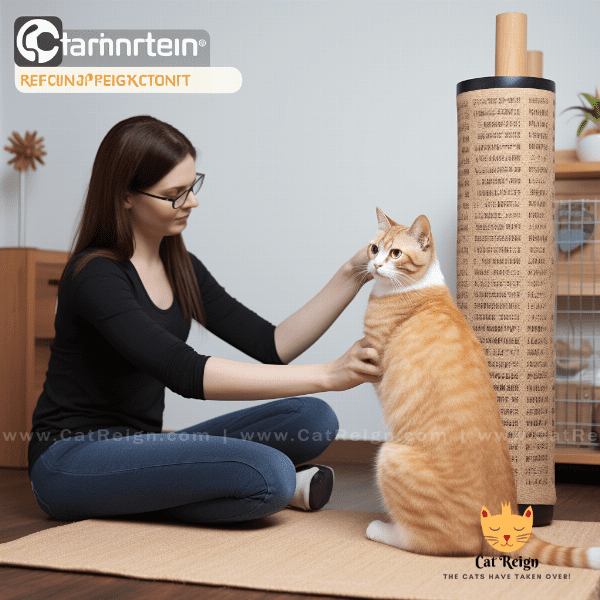
Seeking Professional Help if Needed
Underlying Medical Issues
Sometimes, cats may scratch excessively due to underlying medical issues such as allergies or skin irritations. A veterinarian can assess your cat’s health and provide treatment if needed.
Behavioral Issues
Behavioral issues such as anxiety, stress, or aggression can also cause cats to scratch excessively. An animal behaviorist can assess your cat’s behavior and provide advice and training tailored to their individual needs.
Inappropriate Scratching
If your cat continues to scratch furniture despite the use of suitable scratching alternatives and deterrents, a professional can help you identify the root cause of the problem and provide effective solutions.
Compulsive Scratching
Compulsive scratching is a rare but severe behavioral problem that requires professional intervention. A veterinarian or animal behaviorist can diagnose the condition and provide treatment, which may include medication or behavioral therapy.
Seeking professional help may seem like a daunting task, but it can be a crucial step in preventing your cat from scratching furniture. A veterinarian or animal behaviorist can provide tailored advice and solutions to address your cat’s specific needs and ensure their well-being.

Managing Stress and Anxiety in Cats
Stress and anxiety can be significant factors that contribute to a cat’s scratching behavior. Managing your cat’s stress and anxiety can be an effective way to prevent them from scratching your furniture. Here are some tips for managing stress and anxiety in cats:
Provide a Safe and Comfortable Environment
Creating a safe and comfortable environment for your cat is crucial in reducing stress and anxiety. Provide a quiet and secluded space where your cat can retreat to when they feel overwhelmed or anxious. Offer comfortable bedding, toys, and hiding places to make them feel secure.
Establish a Routine
Establishing a routine can help to reduce stress and anxiety in cats. Set regular feeding, playtime, and sleep schedules to provide a sense of stability and predictability for your cat.
Use Pheromone Therapy
Pheromone therapy can be an effective way to manage stress and anxiety in cats. Pheromone sprays or diffusers mimic the scent of a cat’s natural pheromones, which can have a calming effect and reduce anxiety.
Provide Adequate Stimulation
Providing adequate stimulation is essential in preventing boredom and reducing stress and anxiety in cats. Offer toys, scratching posts, and interactive playtime to keep your cat mentally and physically stimulated.
Consider Medication
In severe cases, medication may be necessary to manage your cat’s stress and anxiety. Consult with a veterinarian to discuss medication options and possible side effects.
Managing stress and anxiety in cats can be a challenging task, but it’s essential in preventing unwanted scratching behavior. Provide a safe and comfortable environment, establish a routine, use pheromone therapy, provide adequate stimulation, and consider medication if needed. By addressing your cat’s stress and anxiety, you can improve their overall well-being and prevent them from scratching your furniture.
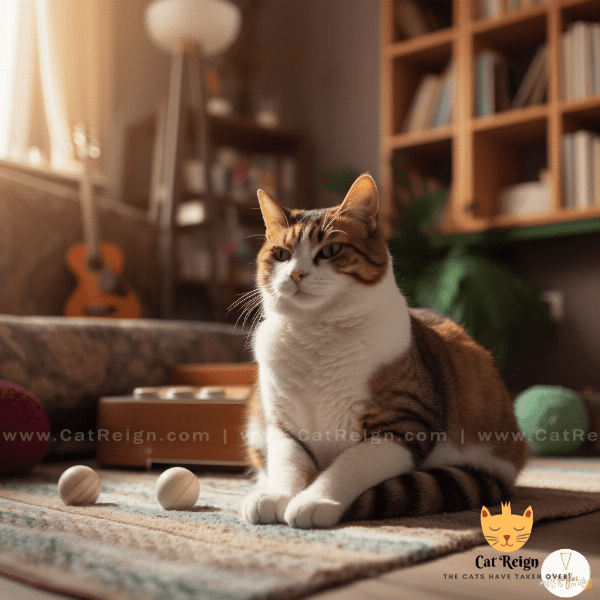
Conclusion: Keeping Your Furniture Scratch-Free
Preventing your cat from scratching your furniture requires patience, persistence, and a willingness to try different solutions. Here are some key takeaways to keep in mind:
Understand Why Cats Scratch
Understanding why cats scratch is essential in preventing them from scratching your furniture. Cats scratch to stretch, mark their territory, and sharpen their claws.
Provide Suitable Scratching Alternatives
Providing suitable scratching alternatives is crucial in preventing cats from scratching your furniture. Scratching posts, mats, and cardboard scratchers are excellent options.
Use Deterrents to Protect Furniture
Using deterrents can help to protect your furniture from scratches. Anti-scratch sprays, vinyl covers, and slipcovers are all good options.
Trim Your Cat’s Nails Regularly
Trimming your cat’s nails regularly is important in preventing them from scratching your furniture. Start early, use the right tools, and reward your cat for their cooperation.
Create a Positive Reinforcement Environment
Creating a positive reinforcement environment can help to teach your cat to scratch in appropriate areas and deter them from scratching in inappropriate ones.
Cover Furniture with Scratch-Resistant Materials
Covering your furniture with scratch-resistant materials can be an effective way to protect it from scratches. Microfiber, leather, and slipcovers are all good options.
Seek Professional Help if Needed
If your cat’s scratching behavior persists despite your efforts, seek professional help. A veterinarian or animal behaviorist can assess your cat’s behavior and provide tailored solutions.
By implementing these tips and solutions, you can prevent your cat from scratching your furniture and maintain a happy and healthy relationship with your furry friend. Remember to be patient, consistent, and persistent in your efforts, and don’t hesitate to seek professional help if needed.
